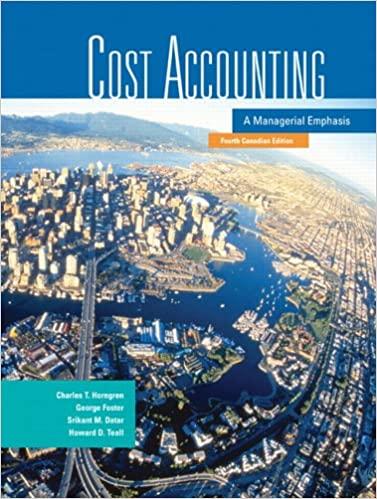Multiple choice, comprehensive problem on relevant costs. The following are the Class Companys unit costs of manufacturing
Question:
Multiple choice, comprehensive problem on relevant costs. The following are the Class Company’s unit costs of manufacturing and marketing a high-style pen at a level of 20,000 per month:
CHAPTER 11 Manufacturing costs:
Direct materials Direct manufacturing labour Variable manufacturing indirect costs Fixed manufacturing indirect costs Marketing costs:
Variable Fixed
$1.10 1.32 0.88 0.55 1.65 0.99 Required The following situations refer only to the preceding data; there is no connection between the situations. Unless stated otherwise, assume a regular selling price of $6.60 per unit.
Choose the best answer to each of the seven questions. Support each answer with summarized computations.
1. In an inventory of 10,000 units ofthe high-style pen presented on the balance sheet, the unit cost used is
(a) $3.30,
(b) $3.85,
(c) $5.50,
(d) $2.42,
(e) $6.49.
2. The pen is usually produced and sold at the rate of 240,000 units per year (an average of 20,000 per month). The selling price is $6.60 per unit, which yields total annual sales of $1,584,000. Total costs are $1,557,600, and operating income is $26,400, or $0.11 per unit. Market research estimates that unit sales could be increased by 10% if prices were cut to $6.38. Assuming the implied cost behaviour patterns are correct, this action, if taken, would
a. Decrease operating income by a net of $7,920
b. Decrease operating income by $0.22 per unit ($52,800) but increase operating income by 10% ofsales ($158,400) for a net increase of $105,600
c. Decrease unit fixed costs by 10%, or $0,154, per unit, and thus decrease operating income by $0,066 ($0.22 — $0,154) per unit
d. Increase unit sales to 264,000 units, which at the $6.38 price would give total sales of $1,684,320; costs at $6.49 per unit for 264,000 units would be $1,713,360; and a loss of $29,040 would result
e. None ofthese 3. A cost contract with the government for 5,000 units of the pens calls for the reimburse¬
ment of all manufacturing costs plus a fixed fee of $1,100. No variable marketing costs are incurred on the government contract. You are required to compare the following two alternatives:
Sales Each Month to Alternative A Alternative B Regular customers 15,000 units 15,000 units Government 0 units 5,000 units Operating income under alternative B is greater than that under alternative A by
(a) $1,100,
(b) $2,750,
(c) $3,850,
(d) $330,
(e) none ofthese.
4.Assume the same data with respect to the government contract as in requirement 3 except that the two alternatives to be compared are:
Sales Each Month to Alternative A Alternative B Regular customers Government 20,000 units 0 units 15,000 units 5,000 units Operating income under alternative B relative to that under alternative A is
(a) $4,400 less,
(b) $3,300 greater,
(c) $7,150 less,
(d) $550 greater,
(e) none of these.
5. The company wants to enter a foreign market in which price competition is keen. The company seeks a one-time-only special order for 10,000 units on a minimum-unitprice basis. It expects that shipping costs for this order will amount to only $0,825 per unit, but the fixed costs of obtaining the contract will be $4,400. The company incurs no variable marketing costs other than shipping costs. Domestic business will be unaffected. The selling price to break even is
(a) $3.85,
(b) $4,565,
(c) $4,675,
(d) $3.30,
(e) $5.50.
6. The company has an inventory of 1,100 units of pens that must be sold immediately at reduced prices. Otherwise, the inventory will be worthless. The unit cost that is relevant for establishing the minimum selling price is
(a) $4.95,
(b) $4.40,
(c) $3.30,
(d) $6.49,
(e) $1.65.
7. A proposal is received from an outside supplier who will make and ship these high-style pens directly to the Class Company’s customers as sales orders are forwarded from Class’s sales staff. Class’s fixed marketing costs will be unaffected, but its variable marketing costs will be slashed by 20%. Class’s plant will be idle, but its fixed manufacturing overhead will continue at 50% of present levels. How much per unit would the company be able to pay the supplier without decreasing operating income?
(a) $5,225,
(b) $4,345,
(c) $3,245,
(d) $5,885,
(e) none ofthese.
Step by Step Answer:

Cost Accounting A Managerial Emphasis
ISBN: 9780131971905
4th Canadian Edition
Authors: Charles T. Horngren, George Foster, Srikant M. Datar, Howard D. Teall





